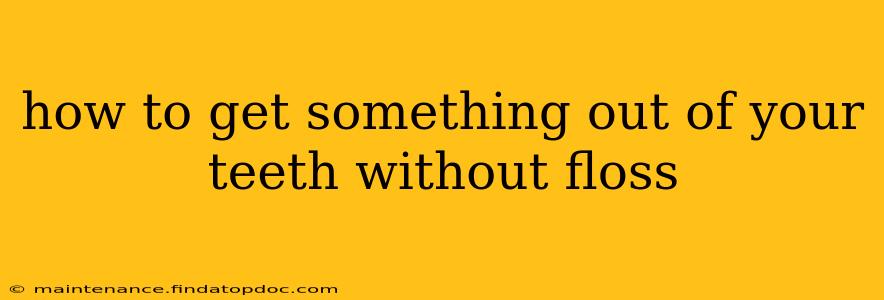Getting something stuck between your teeth is frustrating, especially when you don't have floss on hand. Fortunately, there are several effective alternatives you can try. This guide will explore various methods, addressing common concerns and providing practical solutions. Remember, while these methods can be helpful in a pinch, regular flossing remains crucial for optimal oral hygiene.
What Can I Use Instead of Floss?
This is a common question, and the answer depends on what's available to you and the nature of the stuck object. Here are some options:
A Toothpick:
A toothpick can be surprisingly effective for removing small, easily accessible food particles. Gently insert the pointed end into the space between your teeth, avoiding excessive force that could damage your gums. Use a back-and-forth motion to dislodge the object. Dispose of the toothpick immediately after use. Important Note: Avoid using toothpicks if you have sensitive gums or bleeding tendencies.
A Water Pick (Oral Irrigator):
A water pick, also known as an oral irrigator, uses a pulsating stream of water to remove food particles and plaque. This is a gentler approach than a toothpick and can often dislodge stubborn bits of food effectively. Simply direct the stream of water towards the affected area.
Your Tongue:
Sometimes, simply using your tongue can dislodge small pieces of food. Gently try to work the object out using your tongue’s natural pressure. However, this method is only effective for loosely lodged particles.
What if It's Really Stuck?
If the object is deeply embedded or particularly stubborn, you shouldn't force it. Attempting to remove it with excessive force can damage your teeth or gums.
Wait and See:
For very small particles, sometimes they'll work themselves loose naturally. If the object isn't causing you pain or discomfort, it's worth waiting a little while to see if it dislodges on its own.
Consult a Dentist:
If the object remains stuck and you're experiencing any discomfort, pain, or bleeding, it's best to schedule an appointment with your dentist. They have the tools and expertise to safely remove the object and assess any potential damage.
How to Prevent Food Getting Stuck in Your Teeth?
Prevention is key! Here are some strategies to minimize this common problem:
Thorough Chewing:
Chew your food thoroughly to break it down into smaller pieces before swallowing. This will reduce the likelihood of large particles getting lodged between your teeth.
Proper Brushing and Flossing:
Regular brushing and flossing are the most effective ways to prevent food particles from accumulating between your teeth. Aim for twice-daily brushing and once-daily flossing.
Dietary Choices:
Consider the types of food you eat. Sticky or stringy foods are more prone to getting stuck.
Frequently Asked Questions (FAQs)
What's the best way to remove popcorn kernels from between my teeth?
If the kernel is small and relatively loose, a toothpick or a water pick might work well. However, if it is deeply embedded or causing discomfort, see your dentist for removal.
Can I use dental tape instead of floss?
Dental tape is a slightly wider alternative to floss, potentially making it easier to remove stubborn particles. However, it is not readily available in all locations.
Is it okay to use a safety pin to remove something stuck in my teeth?
Absolutely not. A safety pin is far too sharp and could easily damage your gums or teeth, leading to infection or significant injury. Never use a safety pin or any other sharp object to try to remove something stuck in your teeth.
This article provides guidance and should not be considered medical advice. Always consult a dental professional for concerns about your oral health. Regular dental check-ups and proper oral hygiene are crucial for maintaining healthy teeth and gums.
